
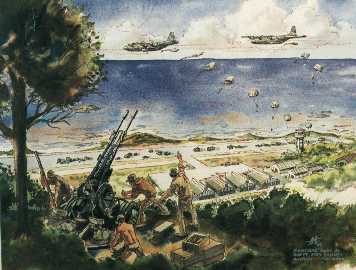
Airborne-amphibious rescue of Grenada--Jump under 500 feet with U.S. Army Rangers below Cuban anti-aircraft guns! Click on thumbnails to view larger image of pictures and experience the first victory since Vietnam in the Cold War!
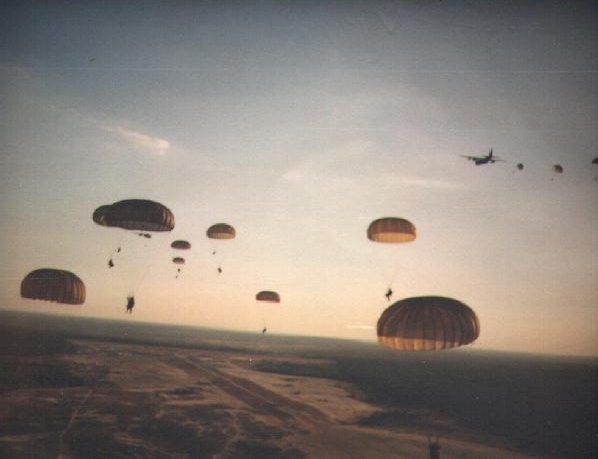

President Ronald Reagan boldly ordered the rescue of U.S. medical students and the capture of the Soviet 10,000 foot strategic runway from Cuban and PRA forces

STRATEGIC SITUATION MAP
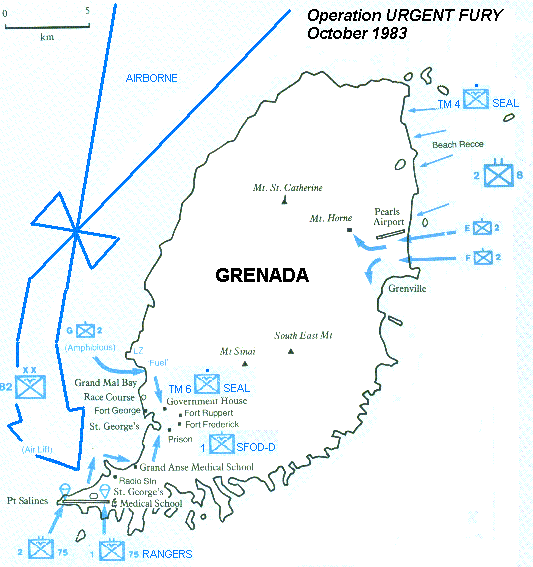
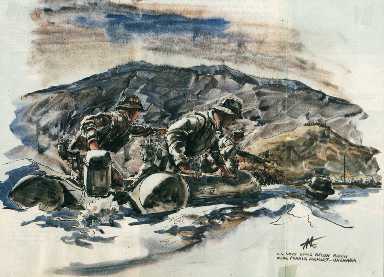 Men of Lt Mike Walsh's Seal Team 4 conduct a successful beach reconaissance near Point Salines airport, finding the beach heavily defended and resulting in the Airborne Course Of Action (COA) being chosen. Later beach surveys showed poor conditions for landing craft like the tracked LVTP(AAV)-7s, resulting in a heliborne assault on Pearls Airport to the north.
|
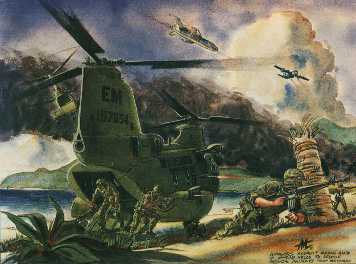
After parachuting onto the island, Army Rangers destroyed a BRDM wheeled armored car attack with 90mm Recoilless rifle fire, and then hopped on board marine helos to rescue students held at the St. George's Medical college Grand Anse campus--NOT McForce recon as the Hollywood movie "Heartbreak Ridge" shows; note USAF AC-130A "Spectre" gunship and Navy A-7D Corsair II aircraft firing in support, AC-130s took out Cuban/PRA AA guns, BRDMs at key moments in the fighting
|

Paratroopers of the 82nd Airborne Division after helping the Rangers clear Point Salines runway were the first to wear the PASGT Kevlar helmet into battle, here with ghillie camouflage strips and M72A2 66mm LAAW Light Anti-tank/assault Weapons (rockets) strapped to the top of ALICE rucksacks |
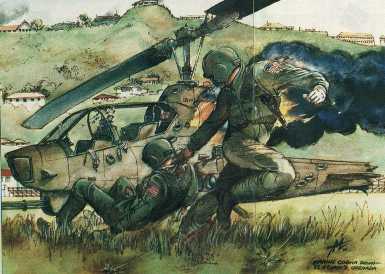
2 marine unarmored AH-1T SeaCobra helicopters were shot down just by small arms fire from the meager Cubans and PRA; here CPT Jeb Seagle drags CPT Tim Howard to safety from their burning craft, CPT Seagle seconds later was gunned down by the enemy. Today, marine Cobras are still unarmored, go figure! |
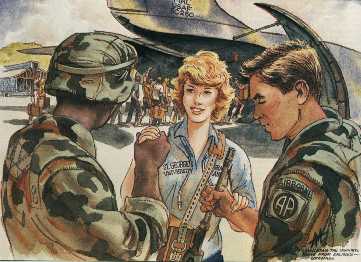
"All American" 82nd Airborne Paratroopers receive thanks from a shapely American female St. George's medical student for her rescue
|
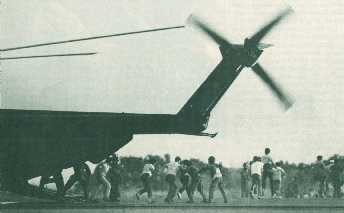
Students were shuttled from their campus locations to USAF C-141 Starlifter jet transports at Point Salines airport to hometown U.S.A. and safety--- |
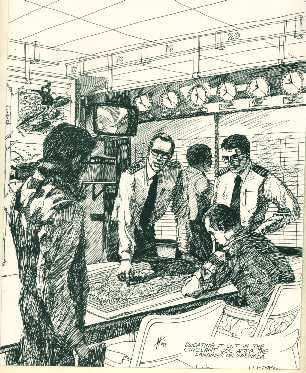
Back at headquarters, planners worked overtime to pinpoint the locations of all American citizens and corner fleeing Cuban/PRA Soldiers |
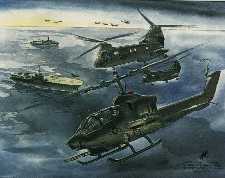
Assigned the north part of the island, marine transport helicopters from the USS Guam did prove handy at inserting Army Rangers and extracting medical students. Cobras did not fare as well as 2 were shot down, leaving only 2 remaining for fire support fortunately not needed. |
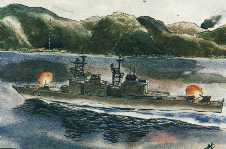
After PRA forces in BTR-60PB armored cars chased off men from Seal Team Six (didn't bring M72 LAW anti-tank rockets) holding the radio transmittor, 5" guns from the USS Caron tried to silence the station. Note the extreme closeness needed to engage a shore target with 5"/54 guns, a vulnerability the British in the Falklands War learned well the year before |
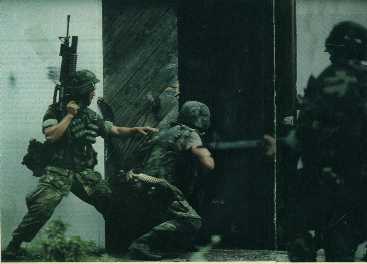
Kevlar-helmet clad 82nd Airborne Paratroopers with M60 MMG storm into a room in search of hiding Cuban and PRA Soldiers |
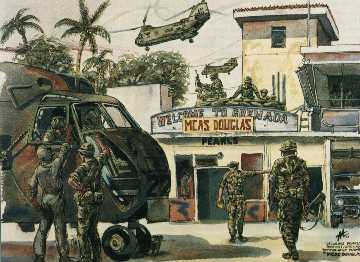 In the north part of the island, marines saw no enemy action or resistance, find Pearls airport empty |
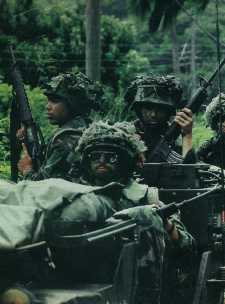
M151 4x4 gun-jeep of the 82nd Airborne Division with stylish Paratroopers with ghillie strip camouflaged helmets |
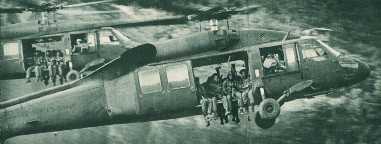
Friendly OAS Soldiers were flown in by UH-60A Blackhawk heliopters from Barbados to peacekeep after the fighting was over |
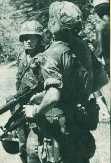
Airborne officers confer to decide on their next Course Of Action (COA) |

Wounded Soldier with I.V. rushed to UH-60 "Dust-off" MEDEVAC helicopter to be flown to Navy amphibious ships where their landing was delayed due to Navy squabbling over who was going to pay to refuel the helicopter |
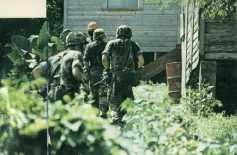 Paratrooper fire team on patrol in the lush foilage of the "Spice Island" |
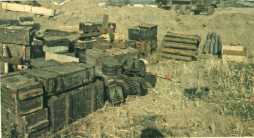
Enormous amounts of weapons, ammunition and supplies were captured BEFORE they could be flown into Latin America to create wars and rebellions |
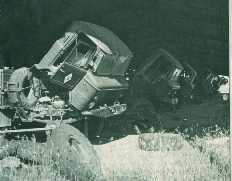
Soviet-made trucks were flown in to prop up the communist regime that had ousted the formerly friendly to the U.S. ruler, Maurice Bishop |
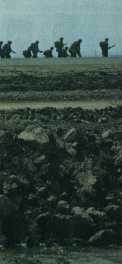
Rangers and Paratroopers scoured the island in search of hiding enemy Soldiers wearing civilian clothes |
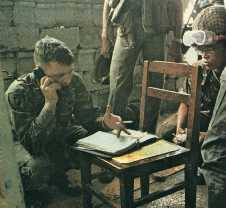
Airborne S-3 officer's work station: any flat surface, a map and a radio! |
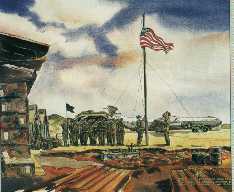
The Battle for Grenada, won by the forces of freedom, the turning point in the Cold War when America proved it could fight and win on the ground |
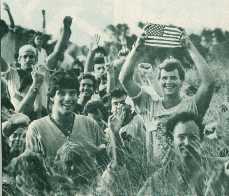
American students cheer their Airborne rescuers before flying by USAF transports back to CONUS
|
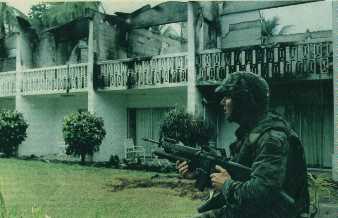
82nd Airborne Paratrooper scanning for signs of the enemy with a M16A1 5.56mm Assault Rifle/M203 40mm Grenade launcher
|

Unlike in Vietnam, the civilian populace was very glad to see the U.S. Army Airborne come to restore their country back to them.
|
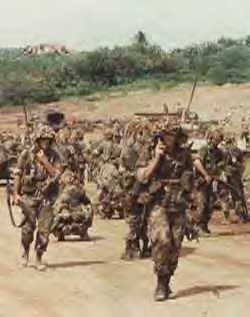
Helmet camouflage-clad 82nd Airborne Paratroopers move out across the island after airlanding from USAF C-141B Starlifter jets...airlanding onto a single runway creates a bottleneck with other aircraft circling overhead waiting to land as the plane that lands offloads, then taxis back down the runway to make an upwind take-off. One of the lessons learned from Grenada is to have ALL of the assault echelon parachute airdrop to avoid this combat power build-up delay, a lesson applied ruthlessly in Panama 6 years later, resulting in the collapse of the PDF and capture on strongman Manuel Noriega who sits in a Florida prison as we write this! |
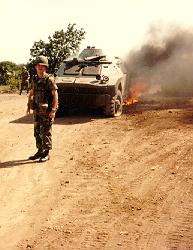
An Army Ranger officer stands in front of what appears to be a burning BTR-60PB or BRDM armored scout car set aflame by either a LAW rocket or 90mm recoilless rifle round. According to Grenada, 1983 by Lee Russell, Mike Mendez and Paul Hannon, eight BTR-60PB 8x8 armored cars and two BRDM 4x4 scout cars were supplied by the Soviet Union to Grenada; 6 BTR-60PBs were subsequently destroyed and two captured, 1 BRDM was destroyed and 1 captured by U.S. forces. Note the flattened rubber tires....."Hi, mom!"
|
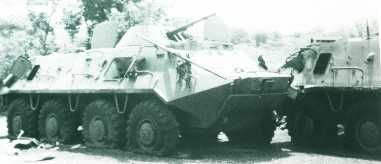
Rubber-tired armored cars like these two BTR-60PBs disabled on Grenada are easily "mobility killed" by shooting out their tires and setting fire to their rubber. At this point you can finish the vehicle off or capture it. You cannot put armored skirts over the rubber tires because the wheels in front have to turn! The entire lower side of an armored car is completely uncovered and only has its thin metal at the body standing in the way of all types of lethal weaponry far more deadly than what was available in 1983. The madness that the U.S. Army in 2008 wants to emulate the BTR-60 with a $3 million dollar 1950s technology LAV-III/Stryker 8x8 wheeled deathtrap is a folly that will result in our men killed in the same manner that the Cubans and PRA were on Grenada.
|
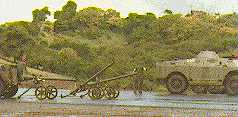
Captured equipment included a BRDM scout car, recoilless rifles and heavy machine guns; perfect for a so-called "peaceful" resort island and Soviet strategic base! |
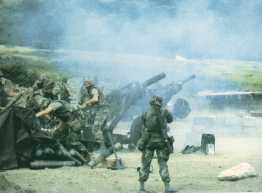
M102 105mm towed field artillery from the airlanded 82nd Airborne Division layed suppressive LZ fires for later helicopter air assaults: ironically a lesson forgotten 19 years later by the aircraft-centric 101st Air Assault Division in Afghanistan during Operation Anaconda but recently rectified when the 82nd Airborne took over duties bringing along new M119 105mm howitzers.
|
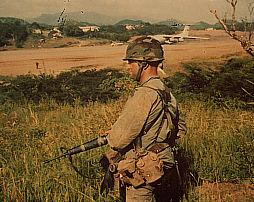
A tired Ranger looks out across the now secure island for signs of any remaining enemy...Notice the old M1 steel helmet and Vietnam Olive Drab OG 107 rip-stop cotton uniform and LC-2 suspenders and ammo pouches. By 1987 the OD green uniform was phased out in favor of the woodland camouflage BDUs, ending an era in the U.S. Army, but not before the ghosts of Vietnam that accompanied this uniform were put to rest with victories in the Cold War begun on Grenada.
|
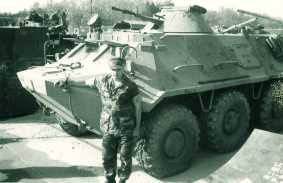 A marine officer stands by one of the Russian-made BTR-60PB armored cars captured in Grenada now used as an OPFOR vehicle at the Infantry Officer's Course (IOC) at Camp Barrett, Quantico Marine Corps Base, Virginia. BTR-60PBs surrounded Seal Team 6 (Not McForce Recon) who earlier fast-roped into the Governor's House to protect Sir Paul Scoon, until marine tanks and AAV-7s were landed |
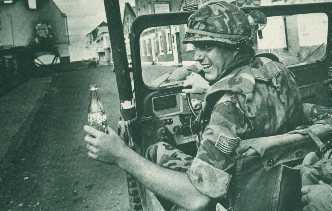
A marine takes a coke break while driving his unarmed jeep through the center of town |
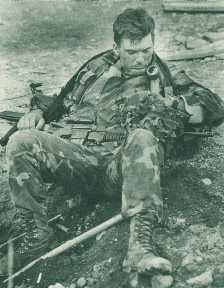
Paratrooper Grenadier takes a well-earned earned rest after the fighting is over |
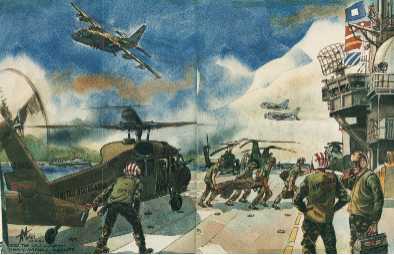
On October 19, 1983, Grenadian Prime Minister Maurice Bishop and a number of his top aides were executed by the People's Revolutionary Army (PRA), on orders from a radical new political group known as the "Revolutionary Military Council." Intending to replace Bishop's Marxist government with an even more virulent Marxist regime, General Hudson Austin and his sixteen member RMC quickly moved to assume control of the island-nation. Fears of the possibility of a new Soviet ally so close to U.S. shores (a fear bolstered by the recent construction of a 10,000 foot runway capable of handling the largest military transports), and the fact that hundreds of U.S. citizens resided in Grenada and might possibly be in danger, caused President Reagan to act to prevent a potentially grave situation from developing. He authorized the U.S. military to intervene effect a noncombatant evacuation operation (NEO) to rescue the American students and, in no small part, to restore a more mainstream government on Grenada.
The U.S. Special Operations (spec ops) community was still in shock and turmoil after marine-piloted navy RH-53D mine-sweeping helicopters ruined the Iranian hostage rescue attempt in 1980. Urgent Fury was a chance for spec ops leaders to restore faith in special operations warfare. The mission included all the current warriors of the Special Operations Command: U.S. Army Rangers supported by the 82nd Airborne Division; Navy Seals; Army "Delta Force"; Air Force Special Tactics Combat Control Teams (CCT), and Squadrons with MC-130 Combat Talon and AC-130 Spectre gunships with the chance inclusion of the 22nd marine amphibious unit (MAU) originally headed to relieve the Battalion Landing Team packed inside one building in Lebanon, that ironically the next day allowed suicide terrorists to wipe them out in a truck bomb blast. All of these units were deployed on the Grenada Task Force.
TACTICAL SITUATION MAP
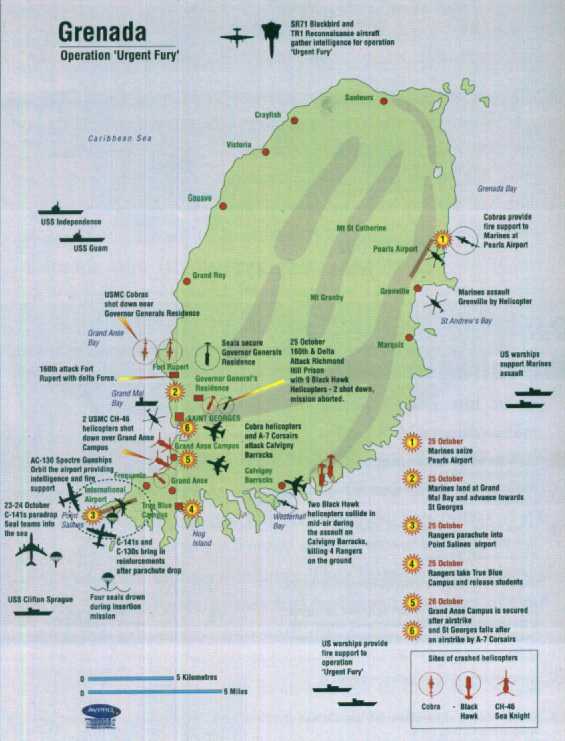
(Click to enlarge)
Although the invasion officially started on October 25th, D-Day, the first troops to enter on Grenada's territory were the Navy SEa Air Land teams or (SEALs). On Oct 23rd, Navy SEAL Team 6 launched a mission to reconnoiter the Point Salines airport. They were tasked to gather intelligence on the condition of the runway for an Airborne assault by U.S. Army Rangers. They were also to place signal beacons on the ground to guide the Rangers to the correct target landing zone (LZ). The SEALs static-line parachuted from the tailgate of a C-130 cargo plane. The 11 SEALs, 1 USAF Combat Controller and three Zodiac F470 rubber boats exited the aircraft, over open ocean, from an altitude of 500 ft. Four of the SEALs, overburdened with excessive equipment and tangled in their parachutes, drowned upon landing in the water. After a brief search for the missing SEALs, the remaining SEAL boat teams resumed their mission. Before they could gain the beach, they were forced to evade an enemy patrol boat. During the evasion, the Zodiac's gasoline-powered outboard motor was swamped and refused to start. The SEALs were forced to abort the mission and paddle to a pickup point.
The next night, the Seals were deployed again on the same mission. This time they launched over sea in the same Zodiacs as before. As they reached the beach, they encountered a vicious surf which swamped the boats. The SEALs lost most of their equipment and were again forced to abort. They returned to their pickup point without gathering any hard intel on the runway conditions or placing the landing beacons for the Rangers.
On the early morning of the 25th, D-Day, another team from SEAL 6 was tasked with securing the Radio Free Grenada transmitting station. The SEAL Team was to capture and hold the radio station for use by an Army Psychological Operations unit. The SEALs inserted at dawn via Blackhawk helicopter. The team seized the station without sizable resistance, but the opposition forces soon counter-attacked with BTR armored cars. The SEALs were forced to destroy the transmitter and escape to the ocean. The mission was considered a success by destroying the enemy's ability to use the transmitter. However, the mission should not have been tasked to SEAL Team 6. The Seals are not designed to seize and hold a position. They are structured to seek a target, destroy it decisively, and then disappear into the ocean. They are not equipped to fight a long term battle, especially in daylight hours. In our opinion, this mission should have been given to U.S. Army Special Forces or Rangers instead of the SEALs.
The third SEAL mission involved Lt. Mike Walsh's SEAL Team 4 performing a beach reconnaissance. This was an example of a perfectly designed SEAL mission with perfect execution. SEAL 4 was to recon a beach near Pearls Airport for a potential marine amphibious invasion. SEALs are specifically trained to measure water depths, analyze the beach for use by tracked vehicles, and estimate enemy defenses. SEAL 4 launched in the middle of the night on the 24th. They moved in F470 Zodiac boats over sea to the objective. The weather was stormy with heavy rain and swells in the sea. The SEALs avoided detection of multiple enemy patrol boats and reached the beach. Two scout swimmers were sent to check on enemy defenses before deploying the team. The scouts reported that the enemy forces had just left the beach due to the heavy rains and no one remained. The SEALs landed on the beach and conducted a "by-the-book" recon. They determined the beach would not support an amphibious landing by the marines and sent back the codes "Walking Track Shoes" to notify the marines that an AIR insertion would be required. The SEALs stayed in place on the beach until daylight and were relieved by the marines after they had secured the Pearls Airport.
The final SEAL mission was the rescue of Governor general Sir Paul Scoon, (Grenada is under the protection of Great Britain, at least in name) and his wife. This was a fitting SEAL mission called a "Snatch and Grab". The plan called for the SEALs to insert near the mansion by hovering helicopter fast rope, secure Governor General Scoon and his wife, and evacuate them and the team by helicopter to safety. Unfortunately, the mission unfolded badly. The insertion by the SEALs went as planned and the SEALs seized the mansion with no opposition. But, while the SEALs were identifying Mr. Scoon, an enemy counter-attack was organized using BTR-60PB armored cars and the SEALs were pinned down inside the building. A firefight started as enemy Soldiers tried to rush the mansion. A SEAL sniper engaged the troops from the mansion roof and killed 21 enemy Soldiers and drove them back. The Seals were trapped in the mansion for nearly 24 hours until they were relieved by a small marine company-sized unit the following day. In the attempts to rescue the pinned down SEALs, two marine AH-1T Cobra helicopters were shot down, killing 3 marines, and reportedly a UH-60 Blackhawk was also downed killing one SEAL and one Army officer. General Scoon, his wife, and nine aides were all safely evacuated without injury. Although the SEALs were not equipped to fight a sustained battle (no M72 LAW rockets to counter enemy armored vehicles), they relied on their training and tactical positioning to successfully complete the mission.
UPDATE!
An excellent After Action Review (AAR) of SEAL missions in Grenada is here on the navyseals.com web site:
www.navyseals.com/community/navyseals/operations_urgentfury.cfm
U.S. Army Rangers were the key to the overall success of the Grenada invasion. The Rangers were tasked with securing the Salines Airport and the True Blue Campus of the Grand Anse Medical School. The Rangers initial plan was to airland three C-130 Hercules aircraft directly on the runway, disembark, and commence direct action contact with opposition forces to secure the airfield. Upon securing the airstrip, the 82nd Airborne Infantry would airland and relieve them, moving out to control the southern part of the island. The Rangers would then send a company to the True Blue Campus to secure the safety of the American students housed there.
The Rangers had little time to prepare for their role in Urgent Fury, the invasion of Grenada. Within hours of receiving orders to move, Ranger units were marshaling at Hunter Army Airfield, Georgia, prepared to board C-130s and MC-130s for the ride to Grenada. Their first objective was Point Salines airfield, located on the island's most southwestern point. While securing the airfield, Rangers were to secure the True Blue Campus at Salines, where American medical students were in residence. As quickly as possible, Ranger units were then to take the Army camp at Calivigny.
Since the Navy SEAL team was unable to get ashore; they were to have provided intelligence on the airfield at Salines. H-hour, originally scheduled during darkness, was moved several times until morning twilight. In the lead MC-130s there were problems with the inertial navigation equipment. Since there were no hatch mount antennas on the cargo doors of the aircraft, communications to Ranger units were delayed while passing through Air Force communications.
While in the air, the Rangers were notified of photographic intelligence indicating obstructions on the field. Instead of landing, the majority of transport would have to drop all the Rangers at Salines so the runway could be cleared. Due to the Seals not placing the beacons or getting any intelligence on the runway condition, and MC-130 Combat Talon sensors indicating the runway was blocked, the Rangers decided to parachute directly onto the airstrip. The Rangers performed a tricky in-flight Parachute Rigging in preparation of the jump. The Rangers would be jumping without reserve parachutes from an altitude of below 500 ft. A mix-up occurred in the air when the lead plane's navigation instruments failed. The aircraft slowed it's approach allowing the other aircraft to pass it by. At dawn, the first Rangers jumped in a mass tactical formation and landed on the runway. Unfortunately, the first group of jumpers on the drop zone (DZ) was the command and staff elements. The assault force was a half hour late arriving at the DZ. The staff element came under immediate fire from a small force of Cuban engineering reservists.
In some aircraft the men were told to remove their harness, rucksack, and main and reserve parachutes. These items were placed in kit bags and moved forward to facilitate off-loading troops and cargo. But before long, the USAF Loadmasters were yelling, "Only thirty minutes fuel left. Rangers are fighting. Jump in Twenty minutes."
These Rangers now had to re-rig for the drop, unpacking non-essential equipment and pulling on parachutes. Rucksacks had to be hooked under the reserve pack and weapons strapped to the left side. Under these conditions it was not possible for the jumpmaster to check each man, so buddy rigging was employed.
Aboard the lead MC-130, navigation equipment failed and the pilot reported he could not guarantee finding the landing zone. Rain squalls made it impossible to employ a lead change, so both lead aircraft pulled away to the south. As the Rangers approached the target, the aircraft were out of assigned order and the planned order of arrival was no longer possible. This meant that the attached 82nd Airborne Division Combat Engineer runway clearing team would not be the first on the field. The Rangers then requested a mass parachute assault, a contingency previously planned, so that only the order of exit from the aircraft would be affected, but the Air Force would not conduct a mass drop.
Despite all these difficulties, the Rangers drove on and at 0534 the first Rangers began dropping at Salines: a platoon of "B" 1/75 and the Battalion Tactical Operations Center (TOC), followed almost 25 minutes later by part of "A" 1/75. Over a half hour later the rest of "A" 1/75, minus seven men were over Salines. It was now 0634, but the remaining men of 1/75 would not be on the ground until 07:05.
Men of 1/75 assembled on the east end of the runway. They were short "C" 1/75, which had been sent with sixty Special Operations Detachment Delta (Delta Force) troops to take the Richmond Hill prison and after that mission was aborted due to no one to rescue, so Delta operators scoured the surrounding hills to help secure them for the drop. The Ranger battalions were already operating below strength. One reason for this seems to have been the fact that a limited number of aircraft and aircrews were trained for night operations.
Over one and a half hours elapsed from the first drop of 1/75 until the last unit was on the ground shortly after seven in the morning. These men jumped from 500 feet so they would be in the air between 12 and 15 seconds and under the line of sight of Cuban anti-aircraft guns. Their drop zone was very narrow because there was water on the north and south sides only a few meters from the runway.
At 07:07 the 2nd Battalion began to drop. For several hours their aircraft had orbited, waiting to unload and refuel. They dropped in a much shorter period, and all but one man was safely on the ground. One Ranger broke his leg, and one Ranger's static line became tangled as he exited the aircraft, dragging him against the tail of the plane before he was hauled back aboard. 2/75 assembled on the western end of the runway.
Command Sergeant Major Eric Haney and Delta Operator who fought on Grenada writes about the 1983 invasion of Grenada in his superb book, "Inside Delta Force" on pages 302 and 303:
"We had just gotten to the top when someone shouted, 'There are the planes!'
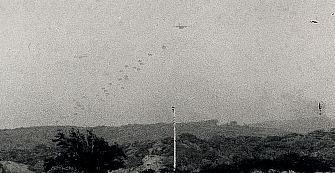
I turned around in time to see a line of C-130s coming in low from the east. But as they approached the leading edge of the airfield, the first two planes were plastered with automatic cannon fire. The lead plane broke away, but the others kept coming, and then you could see the Rangers pouring out the jump doors and into the sky. They were jumping at such a low altitude that their parachutes opened only a few seconds before they hit the ground. Goddam, what a stirring sight!
We quickly got out some air-ground signal panels to let them know we were friendly and fired over the next ridge toward those 23-millimeters to give the gunners a little something to worry about. The first pass of planes had dumped about a company of Rangers and now the planes were circling and heading back for the second drop. Rangers were scattered down the length of the ten-thousand oot runway, just getting out of their parachutes, when two armored vehicles rolled out onto the airfield and started firing their machine guns and heavy cannon.
"Oh hell! Not that!" I yelled in frustration. "The sons of bitches will cut our men to pieces". But almost as soon as the vehicles gained the center of the runway, the Rangers opened fire on them with two 90-millimeter recoilless rifles-abruptly ending the armor threat on Point Salines. Now the second pass was overhead, and the air was full of green parachutes dangling brave men.
So the automatic weapons fire shifted their focus from the airplanes to the men on the ground.
This is bad, this is bad, I thought, watching the fire rip across the far end of the runway. This is when a unit is the most vulnerable. Just as they land and their leaders are scattered and they haven't had the time to reorganize.
But then I saw an amazing sight. The Rangers rose from the ground as one organism, screaming their war cries, and assaulted straight across the runway toward the enemy guns. Within ten minutes, the guns fell silent. The third and last pass of Rangers jumped almost unmolested.
Later that day I learned that a corporal had led the spontaneous assault across the airfield. Somebody said the guy jumped up from the ground and shouted, "I've had enough of this shit!" and took off across the airfield toward the enemy positions. Every man near him jumped up to follow, and the attack spread like wildfire up and down the length of the airfield. Goddamn! What Soldiers!"
Once on the ground, 1/75 was no longer under effective fire, and thus could begin to clear the runway of blocking trucks and bulldozers. Some of the vehicles had keys in them; others were hot-wired and removed. A Cuban bulldozer was used to flatten the stakes that had been driven into the ground with wires between them, and to push aside the drums placed on the runway. For fifteen minutes there was no enemy fire, and the Rangers worked without interruption.
By 10:00, 1/75 had its second platoon at the True Blue Campus and its first and third platoons had moved north of the runway. In the center, "B" 1/75, had moved north and was holding the high ground not far from the Cuban headquarters. Units of 2/75 had cleared the area west of the airfield as well as the area north of their drop zone to Canoe Bay. The airfield was secure, and the C-130s, which had gone to Barbados to refuel, returned to unload equipment not dropped - which included M151 gun jeeps, motorcycles, and Hughes A/MH-6 "Little Birds" otherwise known as MD500 Defender helicopters.
Eight hours after landing, the commander of "B" 2/75, was notified that two Rangers were missing near their positions. The company commander decided the missing men must be near a building which lay between "B" Company and the Cuban positions. A Cuban construction worker was sent forward with an eleven-man Ranger squad under a flag of truce. While the Rangers remained outside, the Cuban entered and spoke with those inside, who agreed to a truce if the Rangers would treat the Cuban wounded. Two Rangers and seventeen wounded Cubans were evacuated. Afterward, the Ranger commander called for the Cubans to surrender, and 80 to 100 did so. The remainder surrendered later, after a brief fight, to the 82nd Airborne.
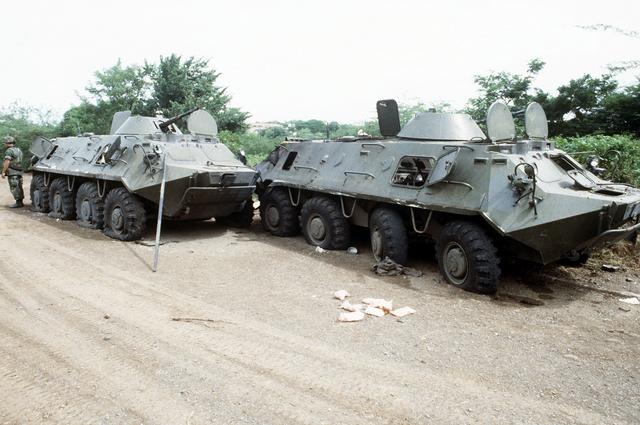
BTR 8x8 thinly armored trucks easily disabled by puncturing their air-filled rubber tires
At 15:30 that afternoon, a counterattack was launched toward "A" 1/75, consisting of three BTR-60s, which moved through 2nd platoons firing positions, firing toward the runway. The Rangers countered with rifles, M60 MMGs, LAWs, and a 90mm recoilless rifle. Two of the BTRs hit each other when the first one halted. Both were disabled. The third began a hasty retreat and was hit in the rear. It was finally destroyed by an AC-130 Spectre gunship.
The last action of the first day took place east of True Blue Campus, where Rangers came under fire from a house on top of a prominent hill, 1,000 meters east of the runway. No Spectre gunship was available, so an A-7D attack plane finally destroyed the house, but only after several duds landed alarmingly near the Rangers.
At the end of the first day in Grenada, the Rangers had secured the airfield and True Blue Campus at a cost of five dead and six wounded. Unfortunately, "C" 1/75, assigned to Delta Force had earlier run into a more difficult situation.

Decades after Grenada, DoD finally admits Little Birds were used on Grenada...here's one delivering a wounded Soldier to a Navy flight deck during the battle...[Photo from Fred Pushies' excellent book: Night Stalkers: 160th Special Operations Aviation Regiment (Airborne) ].
In contrast to the missions completed by the Army Ranger battalions, was the more difficult assignments of SFOD-D, "Delta Force" or "commandos" accompanied by Rangers, flown by TaskForce 160 (now called 160th SOAR) the "Night Stalkers". The two primary objectives were Fort Rupert and Richmond Hill prison. Fort Rupert, which intelligence reported was housing the core of senior advisors to General Austin, was collectively known as the Revolutionary Council. Richmond Hill prison which held scores of illegally imprisoned civil servants and other citizens arrested by the oppressive RMC regime. Ideally, of course, the commandos would have preferred to conduct these operations at night, under cover of darkness. These conditions, too, were favored by the pilots and crew from the Army's elite, and also newly formed, 160th Special Operations Group, known also as Task Force 160, but better known as the "Night Stalkers". Flying MH-60 Blackhawks and A/MH-6 "Little Birds", the 160th had been raised to provide the U.S. SOF community with an all-weather, day/night helicopter capability in response to the failure of the marine pilots at Desert One in 1980. One primary 160th mission was the covert infiltration and exfiltration of SOF personnel into hostile locations. Such would be their tasking in Grenada. Upon receiving word of the pending actions in Grenada, the 160th dispatched a number of Blackhawks from Fort Campbell, Kentucky to a nearby island staging area on Barbados. The "Little Birds" were simultaneously transported by Air Force C-130 and C-5 cargo planes to the same secret location. It was here that they met up with the Commando troopers recently arrived from Fort Bragg.
Richmond Hill prison is located at the bottom of a valley overlooked by a nearby enemy held fort. The Delta team had no accurate maps of the prison and they had no idea of the prison's defenses. The mission was originally tasked to Seal Team 6 operators but was changed to Delta at the last minute. Delta's team had no time to plan an effective campaign and were going in blind without hard intel as well. Due to delays delivering their MH-60 Blackhawk helicopters from Barbados, the Rescue force would have to go in broad daylight instead of under the cover of darkness as planned.
Delta planned on assaulting the prison compound by landing Blackhawk helicopters outside the perimeter. They would then mount an intense frontal attack and overwhelm the defenders. Unfortunately, the prison was built on a hill with steep cliffs on three sides and had no adequate LZ to unload the troopers. When Delta's men discovered the terrain problem, they decided they would hover the aircraft over the prison and fast rope into the compound, surprise the defenders and overwhelm them. As the Delta team flew toward the prison they discovered that the hill was defended by anti-aircraft batteries and also heavily defended from within. Perched on a high ridge whose sides were almost vertical and covered by dense foliage, the prison was surrounded by walls twenty feet high and topped with barbed wire and watchtowers covering the area. Intelligence had failed to report the presence of two antiaircraft guns on a ridge some 150 feet higher then the prison, which brought the Blackhawks under fire. It was impossible to use ropes to lower the Rangers. The helicopters had to remain steady during this operation, making the Rangers and crews easy targets. No air support was possible at this time, since all small aircraft were engaged at Salines. One helicopter was shot up and forced to crash land down hill from the prison but still within range of the defenders. The other choppers landed next to the downed bird and unloaded their payload of troops. The Delta/Ranger team was almost instantly pinned down by enemy fire and eventually had to be rescued by other Rangers from Salines Airport.
At least two attempts were made to bring the Blackhawks in to unload troops, but anti-aircraft fire hit pilots, crew, and the attacking troops. Suppressive fire from the Blackhawks was ineffective because of their violent maneuvers, although some Rangers walked away from the crashed Blackhawks, others were badly hurt and were not immediately evacuated. Part of the evacuation problem seems to have been that Army pilots could not land aboard Navy ships because they were snobbily considered "not qualified" to do so, although this was eventually waived, and they landed without any problems. The Delta operators that were able bodied to fight procedded to the hills surrounding Port Salines airfield to help secure them for the incoming Ranger parachute drop.
At Fort Rupert, however, the situation was much different. Arriving by helicopter, troopers assaulted the complex and rounded up their quarry quickly, without sustaining casualties. Their mission completed, the team called for extraction from the 160th who arrived and transported both the commandos and the detainees to the USS Guam offshore for questioning and formal processing by officials.
Intelligence failed at the prison and also when the Rangers were not informed until 1030 on the morning of the 25 October that there were still students at the second campus at Grand Anse.
A Ranger platoon moved to the True Blue Campus with only light opposition and commenced evacuating students via helicopter. During the evacuations, the Rangers learned that there were many more American students at the main Grand Anse campus. With the help of a student ,who was an amateur HAM radio operator living at the other campus and other students, they learned of enemy guards in the area, but the Rangers thought that they could bring the students out. A heliborne operation with marine airlift from the USS Guam was planned. Using marine helicopter squadron 261 CH-46s, with supporting fire from USAF AC-130 gunships, ships off the coast, and the marines' last two surviving AH-1T Cobra attack helicopters. American suppressive fire would continue until 20 seconds before the Rangers were committed.
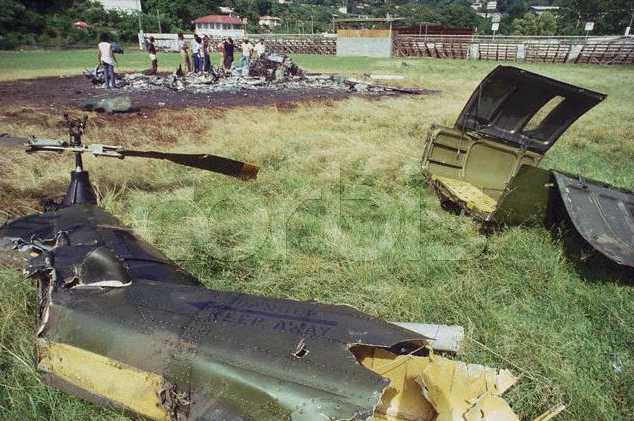
Remains of Howard/Seagle's AH-1T SeaCobra on Grenada
In his excellent 1993 report "Armed Escort For The Future" marine Major Thomas R. Kovach writes about the Cobra helicopter's nagging lack of survivability; a condition that continues to the present day "W" models:
"Survivability of the AH-1W itself is also a concern. The escort aircraft is ineffective if it cannot directly face a simple threat. The only armor onboard the aircraft is found around the pilots' seats. The rest of the aircraft is unprotected and major components are not reinforced to sustain combat damage. The powerful engines are not separated by a ballistic-resistant wall, which means that a catastrophic failure of one will probably result in failure of the other. Even the low threat found in Grenada resulted in the loss of two Cobras similarly protected. Tactics dictate placing the escort aircraft between the transports and the threat. The "wall" provided by the AH-1W is very penetrable."
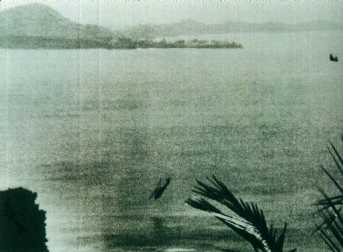
Here the second unarmored Cobra is shot down seconds before crashing into the water. On the right is the CH-46E "Frog" helicopter which has rescued Captain Tim Howard from the first burning AH-1T SeaCobra shoot-down.
The Rangers would fly to the objective in three waves, each composed of three CH-46Es. Each wave of three would carry a company of Rangers, about 50 men. "A" 1/75 would go in first, followed by "B" 1/75, which was to cordon off the campus to prevent outside intervention. "C" 1/75 (-) would then arrive, its mission to locate the students and pack them into four CH-53Ds waiting offshore.
During lift-off the order of aircraft somehow became confused. Instead of the lead flight having 3 x CH-46s carrying "A" 1/75, the first load had one from "A" co. and two from "B" co. Consequently, the second wave had two from "A" co. and one from "B" co. The first three aircraft missed the designated beach in front of the campus. There was sporadic small arms fire, but the only serious damage came from overhanging trees. One helicopter shut down and was abandoned in the surf, but the Rangers scrambled out as water poured in. Later a second marine machine was damaged by a tree.
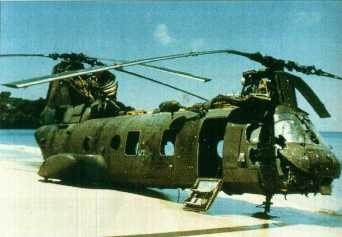
Shot-up USMC CH-46E abandoned on the beach. Notice the absurd dark GREEN paint job: no wonder why it was so easy to shoot down!
The orbiting larger CH-53D Sea Stallions were now brought in to remove the students. The CH-46Es returned and extracted the Rangers, completing the entire operation in 26 minutes. After leaving the beach, they realized that eleven men sent up as a flank guard had not returned. By radio these men were told to move toward positions held by the 82nd Airborne. The Rangers were not sure they could safely enter those lines, so they decided to use one of the inflatable boats from the disabled helicopter. However, the rafts had been damaged during the air assault. The Rangers soon had to swim alongside their damaged boat. Having battled surf and tides for some time, they were spotted, picked up at 2300, and brought to the USS Caron lying off the coast.
One of the Rangers' initial D-day objectives, Calivigny barracks, had not been secured. Lying about 5 kilometers from the airfield, the barracks reportedly housed and trained troops. On 27 October, under the command of a Brigade Headquarters from the 82nd Airborne Division, a full scale attack was carried out by 2/75 and reinforced by "C" (-) 1/75.
Four waves of four UH-60 Blackhawks, each carrying a company to assault the camp, were to fly out to sea before heading to the beach, flying low over the water at about 100 knots. Support was furnished by USAF AC-130 Spectre gunships and Navy A-7Es. At Salines, the Army Airborne Field artillery had seventeen 105mm howitzers, and at sea, the USS Caron would supply naval gunfire support. "A" 2/75 was to land at the southern end of the compound, on the left and right "C" 2/75 was to set down. "B" 2/75 was to land in the southeast, assault suspected anti-aircraft guns, and rejoin the other companies in the north. In reserve was "C" 1/75, which would also hold the southern end of the perimeter.
The Blackhawks came in over the waves, climbing sharply to the top of the cliffs. Quickly the pilots slowed down in order to find the exact landing zone inside the perimeter. Each Blackhawk came in rapidly, one behind the other. The first helicopter put down safely, near the southern boundary of the camp, and was followed by the second. The third Blackhawk suffered some damage, and spun forward, smashing into the second machine. In the fourth Blackhawk, the crew saw what was happening and veered hard right; the aircraft landed in a ditch, damaging its tail rotor. Apparently not realizing that the helicopters rotor was damaged, the pilot attempted to move the Blackhawk, which rose sharply, seemed to spin forward, and crashed. In twenty seconds three machines were down. Debris and rotor blades flew through the air, badly wounding four Rangers and killing three who, sadly, were the only deaths in 2/75.
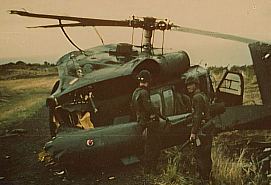
"A" 2/75 regrouped as "C" 2/75 landed on large concrete pads on the edge of the compound. "B" 2/75 also landed safely, and moved on its objective. "C"(-) 1/75 also landed without incident. Contrary to expectations, the barracks were deserted. The Rangers found nothing. That night they slept in the rubble caused by the intense bombardment. This was their last action before returning to the United States.
The Ranger mission was a perfectly designed and executed mission in accordance with Ranger standard operating procedures (SOPs). The Rangers jumped into an airstrip, secured it, and then were relieved by Airborne infantry who pushed outward in all directions to maintain contact with the enemy and defeat him. It was a textbook Ranger mission. The major negatives of the Ranger missions were poor intelligence of the target areas, poor maps and unarmored rubber-tired jeeps for blocking positions when light tracked armored vehicles would have been better. M113 Gavin-type light tracked AFVs could be airdropped or airlanded to accompany Ranger assaults and the lack of organic tracked AFVs would condemn future operations like the October 3, 1993 mission to capture Somali warlords popularly depicted in the book and film, "Blackhawk Down!".
A Grenada Ranger combat vet writes:
"Read your piece on the Rangers need for armor.
I was with 2/75 during Urgent Fury when the jeep team got blasted. I remember the SEAL who E&Ed to Pt. Salines to beg for help for his guys surrounded in the radio station. We got a convoy of gun jeeps lined up to go to the rescue. However, air recon showed armed road block points on the highway. Without armor, the CO had to make the hard decision to leave them to their fate. I have had the opportunity to work with the WIESEL armored vehicle in use by the German Parachute Regt. Three will fit on a C-130, It can be carried internally in a CH-47. It can be airdropped. I wrote a letter to the Regiment to invite them to try out the ones located at Ft. Benning in use by the Battle Lab there. They looked at them, but that was it. Seems there is much prejudice among the hooahs for anything with tracks on it, especially if its not made in the U.S.
I think that SOCOM should form a separate Special Ops Airborne Cavalry Troop to support their operations".
The lack of adequate maps and terrain information not only plagued the Ranger battalions but all forces involved in the conflict. Many commanders only had local tourist travel maps.
The 82nd Airborne Division and the 22nd marine amphibious unit both had very successful missions. Both units acted as conventional infantry units after insertion onto the island. Each unit was originally tasked to secure larger areas than the Ranger units. The 82nd Airborne Division was responsible for the southern half of the island while the marines had the northern half. As the battles for the island unfolded, both units were called upon to react quickly and decisively to multiple unforeseen missions. Both the 82nd Airborne and the 22nd MAU had to bail out one of the Spec Ops teams at one point. Their flexibility and unified command structures were the key to their success.
The Spec Ops units may have had missions that ended in failure or marginal success, but the end result was a decisive victory. The American students were evacuated and any remaining Americans were secure and safe. The lessons learned by the Spec Ops warriors resulted in new operating procedures and eventually a new command being established. The Special Operations forces were reorganized under the U.S. Army 1st Special Operations Command (SOCOM). All U.S. Army Spec Ops units were placed under one command. This reduced the breakdowns in communication, planning, and competition among the groups. The units were organized under a common mission charter and each unit would be tasked only with missions for which they were specialists.
Sweeping changes in policy occurred after the Grenada mission. The doctrine of the Special Operations groups for Low Intensity conflict was written to deal with military incursions such as Grenada and Panama. The invasion of Grenada was necessary to gain the current level of readiness in the Spec Ops commands. It was also successful in stopping the spread of Cuban military readiness in the Gulf region and the restoration of a democratic government in Grenada.
The epic battle for Grenada was the first inter-service combat for the U.S. military in years, done with no notice. In the years to follow, such operations would be practiced constantly resulting in the near flawless invasion, takedown of Panama in 1989 resulting in the capture of dictator Manuel Noriega. This Cold War victory showed that the U.S. was willing to fight for freedom on the ground and prevail. This is decisive MANEUVER, not stand-off firepower.
Click here to e-mail the 1st TSG (A) to more details on the battle of Grenada
Suggested readings:
BOOKS
1. Urgent Fury: the battle for Grenada, Major Mark Adkin
2. At the Hurricane's eye, Greg Walker, U.S. Army SF (Retired)
3. SEAL!, by LCDR Mike Walsh, USN (Retired)
4. Inside Delta Force by CSM Eric Haney (Retired)
5. Grenada 1983, Lee Russell, Mike Mendez and Paul Hannon
WWW
Revolution in Grenada
WHY CAN'T HOLLYWOOD GET GRENADA RIGHT?
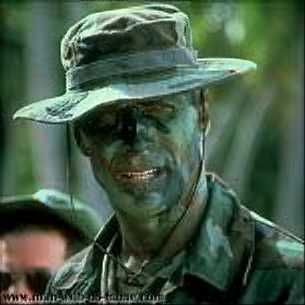
First there was Clint Eastwood's atrocious "Heartbreak Ridge" that foisted the lie of Mc force recon rescuing medical students on Grenada in 1986, then there is this year's The Learning Channel (TLC) pseudo-documentary series "Navy SEALs uncovered" segment on Grenada which blatantly fabricated a story of a mythical marine "REGIMENT" coming ashore to rescue the SEALs trapped in Government house with Sir Paul Scoon and rescuing the medical students. The MAU then and today the MEU is a mere battalion afloat, not a regiment; only 3 MAU/MEUs are afloat at any time an atrocious tooth-to-tail ration for a 172,000 person bureaucracy. A marine tank platoon with a company of infantry in LVTP-7s (now called AAV-7s) did come to Governor's House to relieve the siege, but had nothing to do with rescuing American medical students, which was done by Army Rangers. I guess going to a book store and reading a FACTUAL history of the invasion of Grenada would be too much exertion ("My goodness, READ a book???") for Hollywood or interfere with their afternoon of sunbathing and cold drinks by the pool. Yet, Hollywood seems to want to credit rescuing the American medical students to everyone BUT the actual people who did the deed--the U.S. Army Airborne.
Why is this?
We conjecture that the liberal mind plays "favorites"; the marines and of late the SEALs appeal to the vain, image-conscious but substance-deficient Hollywood crowd because they more closely resemble themselves in outlook. The SEALs hate the Holywood attention as professionals, but the marines revel in any opportunity to exalt themselves at the other service's expense without regard to who actually did the fighting and dying, while proclaiming an "honor" they know nothing about. Why do you think feel-good fluff like "Shakespeare in love" took the best picture Oscar and not the serious and life-reflecting film "Saving Private Ryan"? Most SEALs loath the Hollywood embrace of them in recent years, however, so we don't think they are to blame for the Hollywood Grenada misinformaton. The liberal Hollywood mind simply cannot accept the fact that the lower-key, less visible parts of our military are our most effective. Its to the unsung "doers" and not the braggerts that this web page is dedicated to, and in the hopes that someday a serious film maker will accurately portray the real heroes of Operation Urgent Fury.
These pages look best using Netscape Communicator 4.0 or Internet Explorer 4.0.
To download a copy, click on the buttons below.
Here for Netscape
Here for IE
Return to 1st Tactical Studies Group (Airborne)
Return to Airborne Equipment Shop
















































